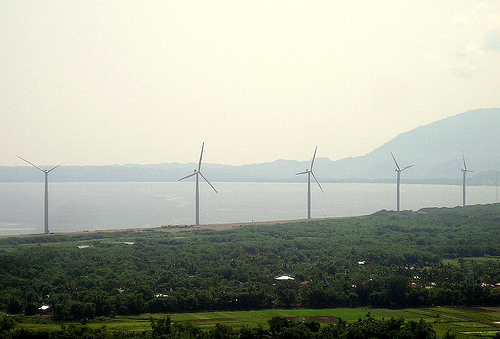Philippines’ Largest Wind Energy Project Secures $315 Million Loan
October 29th, 2014 by Mridul Chadha
Project developers in the Philippines are pushing for rapid development of renewable energy projects so as to take advantage of the country’s feed-in tariff policy. A major wind energy project in the country is set to be commissioned soon.
Energy Development Corporation in the Philippines has signed a loan agreement worth $315 million with several national and international banks to help fund the country’s largest wind energy project. The Burgos Wind Project is in its final stages of commissioning and will be the first to take advantage of the feed-in tariffs offered under the Renewable Energy Act of 2008.
The loan will be disbursed in US dollars as well as Philippine Peso and will mature in 15 years. The foreign funding has been provided by Australia and New Zealand Banking Group Ltd., DZ Bank AG, ING Bank NV, Malayan Banking Bhd (Maybank), and Norddeutsche Landesbank Girozentrale. While the domestic funding was provided by BDO Unibank Inc., Land Bank of the Philippines, Philippine National Bank and Security Bank Corp.
The size of the project highlights the growing confidence among banks in the country’s renewable energy policy. Under the feed-in tariff scheme, the government would provide feed-in tariffs to 200 MW of wind energy projects on a “first to commission, first served” basis. This project alone represents 150 MW wind energy capacity.
The project will include 50 of the Vestas V90-3 MW turbine. The project is expected to generate 370 GWh of electricity every year and offset about 200,000 tonnes of carbon dioxide emissions. While EDC has established several geothermal power projects. The company is now venturing into solar and wind energy sectors. The Department of Energy has awarded the company contracts for one solar power project and six wind energy projects.
The Philippines has set a target to significantly increase its renewable energy capacity by 2030. The government aims to have an installed renewable energy capacity of 15,400 MW to account for half of the country’s power demand.
Keep up to date with all the hottest cleantech news by subscribing to our (free) cleantech newsletter, or keep an eye on sector-specific news by getting our (also free) solar energy newsletter, electric vehicle newsletter, or wind energy newsletter.
-
Marion Meads
-
Offgridman
-


























